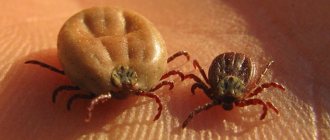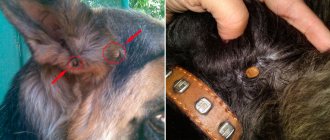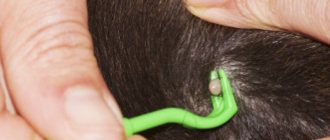Tick-borne encephalitis
Tick bite
Borreliosis
13292 November 11
IMPORTANT!
The information in this section cannot be used for self-diagnosis and self-treatment.
In case of pain or other exacerbation of the disease, diagnostic tests should be prescribed only by the attending physician. To make a diagnosis and properly prescribe treatment, you should contact your doctor. We remind you that independent interpretation of the results is unacceptable; the information below is for reference only.
Ixodid tick research: indications for use, rules for preparing for the test, interpretation of the results and normal indicators.
Indications for the purpose of the study
The indication for performing the study is the attachment of a tick to the human body.
Ixodidae) are of greatest epidemiological importance
).
Infections transmitted by ixodid ticks are characterized by spring-autumn seasonality from April to October, however, in regions with warm climates, year-round activity of ixodid ticks is observed. Risk groups for the incidence of infections transmitted by ixodid ticks are residents of urban and rural areas who visit tick habitats. Transmission of infectious agents occurs when infected ticks attach themselves to the human body.
Infections transmitted by ixodid ticks include tick-borne viral encephalitis, ixodid tick-borne borreliosis, tick-borne human granulocytic anaplasmosis, human monocytic ehrlichiosis and others (Q fever, Crimean hemorrhagic fever, tularemia, rickettsiosis).
The causative agent of tick-borne encephalitis
— RNA-containing virus of the genus
Flavivirus
. The incubation period of the disease is, as a rule, 7–14 days from the moment of tick bite, but can last up to 25 days. The infection affects the cells of the brain and spinal cord with the subsequent development of paresis and paralysis.
Identification of the causative agent of tick-borne viral encephalitis in a tick allows for timely emergency prevention of infection. If a positive result is obtained, emergency administration of a specific immunoglobulin is indicated - no later than 72 hours from the moment of the bite. The maximum effectiveness of the drug is observed when it is administered during the first day after the bite.
The causative agent of Lyme disease
- spiral-shaped bacterium of the genus
Borrelia
. The disease develops in 20% of cases after sucking on a tick infected with Borrelia. In 50-80% of patients, local skin inflammation is observed - tick-borne migratory erythema (redness), the diameter of which does not exceed 5 cm. When spreading through the blood, Borrelia affects internal organs, cells of the nervous system, as a result of which meningitis, meningoencephalitis, radiculoneuritis, neuritis can develop cranial nerves.
The causative agent of human granulocytic anaplasmosis
- the bacterium
Anaplasma phagocytophilum
, which infects granulocytes - white blood cells containing granules (neutrophils, eosinophils, basophils). Infection occurs through the bite of a tick infected with bacteria called anaplasma.
Symptoms of the disease include prolonged fever, weakness, headache, sweating, cough, nausea, vomiting, diarrhea, muscle and joint pain. The lymph nodes become enlarged, and damage to the kidneys, liver, and spleen may occur. Inflammation of the membranes of the brain and spinal cord is less commonly diagnosed. The incubation period averages 14 days.
The causative agents of monocytic ehrlichiosis
are bacteria belonging to the genus
Ehrlichia
. They enter the human body with tick saliva, enter the blood through the lymphatic tract and begin to multiply in the cells of the inner surface of blood vessels, in white blood cells - monocytes. After the cell is destroyed, microorganisms leave it and infect others. Internal organs (liver, central nervous system, bone marrow, skin) are affected with the development of infectious granulomas. The clinical picture of ehrlichiosis is similar to granulocytic anaplasmosis.
Human granulocytic anaplasmosis, monocytic ehrlichiosis and borreliosis are indications for antibiotic therapy. With timely detection of the disease and treatment, the prognosis is favorable.
Reception of ticks for examination
Information for the public - accepting ticks for examination
The work schedule of the laboratory of the Federal Budgetary Healthcare Institution "Center for Hygiene and Epidemiology in Moscow", where laboratory research of ticks removed from people is carried out.
Reception is held from 9-00 to 15-30 daily on weekdays (lunch break from 13-00 to 13-30).
In connection with requests from Muscovites, the work schedule of the laboratory of the FBUZ "Center for Hygiene and Epidemiology in Moscow" on weekends was changed. On Saturday and Sunday, ticks are accepted for examination from 9-00 to 15-00, on holidays - from 9-00 to 14-00.
Receive research results within 48 hours. Tel..
If the results are positive, the laboratory’s medical workers will provide information immediately by calling the phone number you provided. When contacting the laboratory, you must provide information about the date and territory where the tick bite occurred (region, region, locality), and a contact telephone number for anti-epidemic measures.
If you receive a positive result from a laboratory test of a tick, you must urgently seek medical help to administer human immunoglobulin against tick-borne encephalitis no later than the 4th day (96 hours) after the tick has been bitten.
When and where can I get vaccinated against tick-borne viral encephalitis?
In all Moscow administrative districts, from March to September, vaccination points operate annually at the bases of clinics, medical units, health centers of educational institutions, including the State Budgetary Healthcare Institution City Clinic No. 5, Branch No. 2 (Trubnaya St., 19, building 1, tel. ), upon presentation of a compulsory medical insurance policy.
Only a doctor can give advice on vaccination.
Vaccination against tick-borne encephalitis must begin no later than 1.5 - 1 month before leaving for an unfavorable territory.
The vaccination consists of 2 injections, the minimum interval between which is from 14 days to 1 month, depending on the vaccines used. After the last injection, at least 14 days must pass before leaving for the outbreak. During this time, immunity is developed. After a year, it is necessary to do a revaccination, which consists of only 1 injection, then the revaccination is repeated every 3 years.
If a person does not have time to get vaccinated before leaving, in emergency cases, human immunoglobulin against tick-borne encephalitis can be administered before leaving for an unfavorable territory (pre-exposure prophylaxis), the effect of the drug appears after 24 - 48 hours and lasts about 4 weeks.
What to do and where to go
, if you are not vaccinated and a tick occurred while visiting an area unfavorable for tick-borne encephalitis?
Unvaccinated persons are given emergency seroprophylaxis - administration of human immunoglobulin against tick-borne encephalitis no later than the 4th day (96 hours) after tick ingestion (around the clock):
- adults in the City advisory office on vaccine-serum prevention of tick-borne viral encephalitis at the State Clinical Infectious Diseases Hospital No. 2 (Moscow, 8th Sokolinaya Gora St., 15), tel.;
- children at the Children's Clinical Hospital No. 13 named after. N.F. Filatova (Moscow, Sadovaya-Kudrinskaya str., 15), tel.
Where to conduct laboratory testing of ticks?
The study of ticks is allowed to be carried out only in microbiological laboratories that have a sanitary-epidemiological conclusion on the conditions of working with pathogenic biological agents of pathogenicity group 2.
A study of ticks removed from people for infection with the tick-borne encephalitis virus can be carried out in the microbiological laboratory of the department of especially dangerous infections of the Center for Hygiene and Epidemiology in Moscow at the address: Moscow, Grafsky lane, 4/9, tel..
Reception is held from 9-00 to 15-30 daily on weekdays (lunch break from 13-00 to 13-30), the results of the research can be found out from 9-00 to 16-30. If the results are positive, the laboratory’s medical workers will provide information immediately by calling the phone number you provided. When contacting the laboratory, you must provide information about the date and territory where the tick bite occurred (region, region, locality), and a contact phone number.
Tick research is also carried out at the Federal Center for Hygiene and Epidemiology of Rospotrebnadzor, Varshavskoye Shosse, 19a. Tel.,.
Preparation for the procedure
If you find an attached tick, you must go to a trauma center to remove it from the body.
If this is not possible, the tick should be removed yourself. To do this, you need to intercept the tick's body with gauze-wrapped fingers or tweezers strictly perpendicular to the surface of the body, as close as possible to its oral apparatus. Then, turning the tick's body around its axis, remove it. It is not recommended to lubricate the bite site and the tick itself with oil. The tick with a piece of damp cotton wool must be placed in a tightly closed container (a special container with a lid for studying biomaterial, a jar, a test tube, etc.). Ticks taken from different people should not be placed in the same container. Disinfect the wound on the skin with an antiseptic (alcohol, iodine, brilliant green), and wash your hands thoroughly with soap after removing the tick. Deliver the container with the tick to the nearest medical office on the day of removal. Currently, you can purchase special devices for removing ticks, which are sold in pharmacies.
Before examination, live ticks can be stored in the refrigerator at +2 +8°C for up to 1 month. Examination of a dead tick is allowed if it is stored after removal in the refrigerator at a temperature of +2 +8°C for no more than 5 days. Taking into account the risk of developing tick-borne encephalitis and the duration of the study (up to 3 working days), it is better to submit the tick for examination on the day it is removed from the body.
general information
Some people are quite negligent about their health. Arthropod bites do not frighten them, since people do not always imagine the consequences of their indifference. Tick-borne encephalitis is becoming more common every year. Borreliosis is no less dangerous. These infectious diseases often lead to death or severe disability.
The likelihood of disease depends on how long the tick was in the attached state. Therefore, if an embedded arthropod is found on the body, it must be quickly removed. Initial consultation is provided by calling 103 - this is the ambulance control room. Most likely, the operator will send you to the regional emergency room or to the SES. Not everyone knows where ticks are removed in Moscow; this can be done in any medical institution.
But it is not always possible to quickly get to the hospital. In this case, you need to remove the tick yourself. For this use:
- curved tweezers;
- surgical clamp;
- special device.
To remove an arthropod, you need to hold it closer to the proboscis and carefully pull it out, rotating it around its axis. Usually one or two turns is enough. You should try not to make sudden jerks, as this will lead to the head being torn off. In this case, it will remain in the wound, which will lead to inflammation.
Special devices are preferable for use. They do not squeeze the tick’s body, which prevents the contents from being squeezed out into the blood. You can try to remove the arthropod using a thread. The noose is placed over his head, tightened and pulled gently.
Where and where to donate blood for testing
Blood test after a tick bite
In order to respond to the problem in a timely manner and prevent complications, it is recommended to donate blood for borreliosis and an analysis for encephalitis. To obtain reliable information, you need to seek help no earlier than 14 days after the tick has been sucked on. The cost of a blood test is from 700 to 1000 rubles. Results are ready within 32 days. With additional payment for urgency – 4 hours.
Clinic addresses:
- Laboratory of the Federal Budgetary Institution of Health "Center for Hygiene and Epidemiology in the Moscow Region", Mytishchi, st. Semashko, 2 (entrance from the right side of the building, porch - 1st floor). Telephone,. Opening hours: Monday-Friday from 09:00 to 15:00; Sat, Sun – non-working days. A simultaneous study of a tick and blood for 4 infections costs 1055 rubles, for the detection of IgG, IgM antibodies - 345 rubles (one class for one infection). The analysis is carried out within 1-3 days.
- "Institute of Poliomyelitis and Viral Encephalitis", Vnukovo, village. Moscow. Telephone
- Federal Budgetary Institution of Health "Center for Hygiene and Epidemiology in Moscow". Address: Moscow, Grafsky Lane, 4, building 2 (2nd floor, through the main entrance). Tel.. Opening hours: Monday-Wednesday from 9-00 to 12-00. And also Moscow, Varshavskoe highway, 19 A. Tel.: +7 (495) 952-40-98. Opening hours: Monday-Thursday from 9:30 to 15:00, 9th floor room 925 (lunch break from 12:00 to 13:00). Information on the results is provided from 15:00 to 17:30. The laboratory conducts blood tests for antibodies to tick-borne encephalitis, borreliosis, anaplasmosis and ehrlichiosis.
The most accurate picture can be obtained using an immunochip for borreliosis. The cost of the method for detecting antibodies is on average 1,400 rubles. Analysis for demodicosis is carried out in the same laboratories. Cost about 450 rubles. The appearance of demodicosis is in no way connected with the suction of the ixodid tick. Testing the reaction to the encephalitis virus is mandatory for everyone.
Which doctor treats tick-borne encephalitis and borreliosis?
An infectious disease specialist treats tick-borne encephalitis and borreliosis .
There is no need to donate blood for pathogens the next day after a parasite bite. Important: even if infection occurs, antibodies in the blood are formed only after two to three weeks. To assess the dynamics of the body’s immune response, two tests are prescribed with a difference in delivery time of 21 days.
Tick-borne encephalitis
Tick-borne encephalitis is a viral infection that affects the brain and spinal cord. It can occur in various forms and most often ends with the person’s recovery, but with the development of complications of varying severity: convulsions, paralysis, paresis, blindness, loss of hearing and vision.
After an insect bite, 8-22 days pass until the first manifestations of the disease appear, more often 10-12 days. In the early stages, the following may appear:
- feeling of weakness,
- nausea,
- migraine,
- feeling of numbness of the skin in the head and neck area.
Tick-borne encephalitis can be acute, beginning with a rise in body temperature to 39-40°C, observed within 2-10 days. Pain appears in the muscles, head, arms and legs. There may be clouding of consciousness, coma.
Actions in case of an insect bite
A person who has been bitten by a tick has only 96 hours from the moment the parasite was sucked on to prevent the consequences of the incident. Measures taken after this time interval will be ineffective. Actions in the event of a tick bite should be carried out quickly, but calmly, in order to prevent the infected proboscis from being separated from the body of the insect.
The first priority when detecting an attached parasite is to remove it as quickly as possible, but performing rescue procedures on your own is highly not recommended. A common consequence of trying to remove a tick on your own is infection with tick-borne infections (encephalitis, babesiosis, borreliosis, tularemia, etc.) or acariasis (dermatitis, scabies, ixodiasis).
- Italian focaccia
- 5 budget hotels in Sochi for retirees
- 8 simple exercises to relieve eye fatigue
The algorithm for emergency actions aimed at avoiding infection consists of sequentially performing the following steps:
- Go to the emergency department of the medical institution specified in the insurance policy. If you do not have insurance, you must contact the clinic at your place of registration or the emergency department (if the incident occurred on a non-working day). The documents that you should take with you are a compulsory medical insurance or voluntary medical insurance policy, a life and health insurance contract (if available), an identity card (passport, driver’s license).
- Submit the tick that has been removed or detached on its own to a research laboratory for testing to detect infections. If you have insurance, the study of the biting parasite is included in the list of guaranteed free services; if not, it is carried out on a paid basis.
- Donate blood (venous) for a serological test to determine whether the infection was transmitted from a tick to a person. Research results are delivered no later than 3 days from the date of application, but in emergency cases they are prepared within 1 day.
- Carry out seroprophylaxis (administration of injections of immunoglobulin - donor blood containing specific antibodies). The need for preventive measures arises if positive results of laboratory blood tests are obtained or if it is impossible to promptly diagnose the presence of infections.
- 10 principles of intuitive eating for staying healthy
- Crafts for children made from stones
- 6 superfoods from nature











